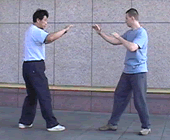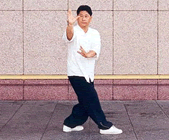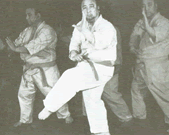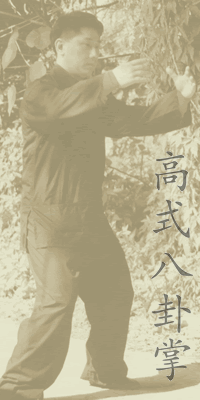
Baguazhang Curriculum at Zong Wu Men
OverviewBaguazhang classes at Zong Wu Men try to balance solo practice with hands-on application with a partner. Unlike many internal schools, students are expected to be conversant in forms and techniques as well their combat applications. Zong Wu men students will learn bagua and xingyi as combat arts. It is at the base of our system to balance the fusion of solo and partner practice so that each supports the other in a complementary, mutual relationship. Solo practice in our school has a few initial main purposes - practices to nourish the body and open the joints, conditioning and power training, work to train the breath and mind, work to train the body's movement, alignment and structure, as well as methods designed to help bring a further depth of focus and awareness to one's intent and bring one's body/mind connection to greater cohesion. Partner practice in our school has a range of different practices as well. There are drills and sparring methods in a range of intensity from fully cooperative to fully uncooperative. There are also paired forms and practices to further train one's body movement, sense of flow and connection, timing, use of momentum, power and quality of mind/intent. Core Components of PracticeThe three main pillars of our Bagua practice are tiangan, xiantian and houtian. The tiangan, literally meaning heavenly stems, are our core body/mind conditioning practice. They are a series of 24 total exercises that are practiced to develop both internal and external conditioning. Though they are often strenuous, they help to develop the power for Bagua's fighting methods and the mental discipline required for deep study of the system. The xiantian, literally meaning pre-heaven, are our main and most important method of practice. They are short solo forms performed while walking on a circle, reflecting their roots as a method of Taoist meditation training. We often will say that the circling methods are for training the body, specifically the Baguazhang Body Method - Bagua Shenfa. In reality, the xiantian are the fount from which all else in bagua is derived. Our houtian combat methods, our throwing methods, our opening and controlling techniques, our body and mind development practice are all derivative of the xiantian, Bagua's circle walking practice. The houtian, literally meaning post-heaven, are short linear combat forms that contain the vast library of our fighting techniques and theories. There are 64 of these short forms in total, composed of 8 sections of 8, each derived from one of the core 8 circling forms.
More on the Zong Wu Men Bagua CurriculumThe YiZong tradition of practice and teaching the art of Baguazhang is a complete approach to understanding its breadth and depth in training a student for stand-up fighting. Each area of practice exists to help out, or to bring increased focus, on some aspect of our training. Here is a list with some more information on the various areas of practice within our system:
More thorough information on Zong Wu Men's system of Baguazhang can be gained in person, through careful, persevering study. Call or write George Wood for more information or to sign up for classes. |
|


 Students will initially be introduced to the basic forms and solo practices of the system with an eye towards providing them with an understanding of the movement, structure and rationality of the system. The drilling of fighting applications and footwork central to our system will also be introduced early in the training process. For many, you will also begin training in basic throws, falls and rolls early in the training and how these practices relate to one's understanding of structure, center, center-line, balance, movement and the solo practices and forms of our system. In the same vein, students will also later begin study of various types of two-person exercises to further develop their skills and understanding of the system.
Students will initially be introduced to the basic forms and solo practices of the system with an eye towards providing them with an understanding of the movement, structure and rationality of the system. The drilling of fighting applications and footwork central to our system will also be introduced early in the training process. For many, you will also begin training in basic throws, falls and rolls early in the training and how these practices relate to one's understanding of structure, center, center-line, balance, movement and the solo practices and forms of our system. In the same vein, students will also later begin study of various types of two-person exercises to further develop their skills and understanding of the system.



